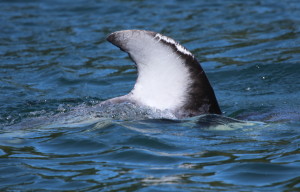Guest post from our newest team member, Natalie Mastick
“I look at pictures of dolphins all day,” is my most common answer when asked what I do for work.

It’s an over-simplified statement, albeit accurate, and it usually leads to many follow-up questions. The most frequent being “Why?” That’s a fair question. I then proceed to explain how by looking at photos of the dorsal fins of dolphins, I can identify individuals, which can be used in calculating population estimates and survival rates. I am usually surprised by the awe that this explanation inspires, as I am somewhat numb to the task after several months of photo analysis. “You can really tell dolphins apart like that?” They have a point; photo-identification is quite remarkable when you think about it.
Photo-identification (photo-ID for short) is a non-invasive way to study marine mammal populations. It’s been used for both cetaceans (dolphins and whales) and pinnipeds (seals and sea lions), and requires a high-resolution photo of each individual. Photo-ID is an effective way to determine individuals based on coloration, markings, scars, fin shape, nicks and notches. For humpback whales, the underside of the fluke is the most recognizable feature, which is can be photographed as the whale dives. For dolphins, one of the most recognizable features is an individual’s dorsal fin, visible as the dolphin breathes at the surface.
I have worked on several projects that use photo-ID, including a long-term study of bottlenose dolphins in Florida, humpback whale population analysis in Antarctica, and currently, a long-term study of Pacific white-sided dolphins in British Columbia with Oceans Initiative. To accomplish this work takes three major steps: photographing wild dolphins, processing the photos, and then looking for matches between the photos.
Oceans Initiative has been taking photos of these dolphins since 2007, which is not an easy feat. Pacific white-sided dolphin are fast and can often travel in large pods of hundreds of animals. Erin, Rob, and their dedicated field team have a ton of experience taking photos of these animals, which provided me with a hearty collection of over 10,000 photos to process. One by one, I went through and determined the quality of each photo. Obviously when photographing hundreds of dolphins quickly surfacing and diving, not every photo will be useable for a photo-ID catalog. I found the photos in which fins were in focus, parallel with the camera, and mostly visible (not partly submerged or covered by water or other dolphins) and then looked carefully at each fin to determine its distinctiveness.
It never ceases to amaze me how different dolphin fins can look. A dolphin can have a single little notch at the base of its fin that makes it completely distinct from the rest of the dolphins seen that day. The combination of scarring, nicks from other dolphins, entanglements, killer whales, and normal wear and tear provide an endless permutation of unique fins. I visually assessed each high-quality photo and determined if the fin was not distinctive, somewhat distinctive by temporary marking or discoloration, moderately distinctive, or highly distinctive. Moderately and highly distinctive fins can be used to identify an individual over longer temporal scales.
Once the fins were scored for distinctiveness, it was then my job to match them to other fins within that encounter, and lastly between encounters from that season. When matching between a single encounter, it’s a lot like a game of memory. You know you’ve seen that fin before, you just need to remember where in order to match them. Once the fins are matched within an encounter, I compile a “best of” folder with all of the identifiable individuals observed in that area to match to the other encounters.
When you include the variable of time, then it becomes more like a game of 6 differences, in which you need to spot what’s changed in a fin over time. Except instead of having two fins that you know are just slightly different versions of the same fin that you’re comparing side-by-side, you need to look through the entire catalog to determine if a fin has actually changed since last identified or if it’s a new individual. Though that’s a fun challenge, it is unlikely that a fin changes much over the course of a few weeks, which means matching fins across encounters is a little easier than across years.
To match fins across encounters, I compile all of the moderately and highly distinctive fins from each encounter and look for individuals seen more than once. The 2016 field season provided over 1000 identifiable photos, which were then compared to each other to determine if there were matches. This is where your imagination comes into play. Looking at these fins enough, you start to see shapes in the nicks and notches and fin shape. There was a fin with a distinctive nick towards the top that looked like the profile of a person yelling. There was another that looked remarkably like a bicep. There was one photo in which a fin caught the light just right and looked like it was reflecting back the shape of a storm trooper.
Reading that back sounds like I’ve kind of lost it. Looking at fins enough might do that to you! But overall, being able to put a minimum number to the dolphins seen last season (think about all the dolphins we couldn’t photograph and the fins that weren’t distinctive enough to match!) is incredibly rewarding, and completing each step of the processing myself was oddly satisfying. I’m hoping we can get a comparable number of photos in 2017, and look forward to seeing some familiar fins in the field.
Natalie Mastick

Pingback:Pacific white-sided dolphin dorsal fin photos and breath samples - Oceans Initiative Oceans Initiative